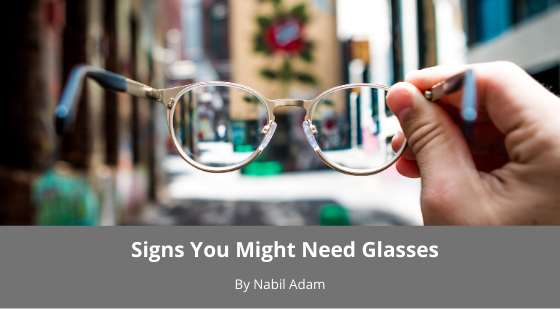We often take our vision for granted. It isn’t something we think about often, so you might not even realize that your vision isn’t what it should be. Typically vision problems arise gradually. Our eyes change over time, and as they do, our vision can become impaired. Over 150 million Americans use corrective eyewear according to a report from The American Academy of Ophthalmology, but many more could likely benefit from corrective lenses. So how do you know if you need glasses? Here are a few signs that you might need corrective lenses.
Squinting
Frequent squinting can be a sign that you are compensating for poor vision. Squinting decreases the amount of light going into the eye and reduces the size of the blurry image. This can temporarily allow clearer sight, but over time will cause strain on the eyes.
Eye Strain
Activities like reading, watching television, or driving can make your eyes feel tired or irritated. Your eyes can become fatigued. If you catch yourself rubbing your eyes frequently, it can be a sign of eye strain. Eye strain can be the result of a lack of sleep, allergies, or a cold, but if it seems to be happening more frequently than it has in the past while you’re going about your daily activities, you should schedule an eye exam.
Headaches
Squinting causes eye strain because it makes the eye muscles work harder to see better. Over time this strain can result in frequent headaches. Corrective eyewear can ease this strain and eliminate the headaches.
Blurred Vision
Blurry vision can be the result of tired, dry, or strained eyes. The edges of objects may become less clearly defined. Blurred vision can indicate a need for corrective lenses, but it can also indicate more severe and urgent issues. If vision suddenly becomes blurry and is persistently blurry – even if only in one eye – it can be a sign of retinal detachment or possibly a stroke. In that case, seek emergency medical attention right away.
Appearance of Halos Around Lights
The presence of auras or halos around light sources can be a sign of vision problems. Halos may become more evident at night, particularly while driving. It could be a sign of cataracts, but they are also associated with uncorrected nearsightedness, farsightedness, astigmatism, and presbyopia.
Difficulty with Vision at Night/Needing More Light to Read
If your vision seems to fade or objects seem less clearly defined under low light conditions, your eyes may be having difficulty adjusting to the darkness. This can be a sign of several different vision issues and warrants an eye exam.
Holding Reading Material Up Close or at Arms Length to See
One prevalent indication of vision problems is how you hold reading materials. If you need to keep them up close to your face, you are likely nearsighted. If you must hold them at arm’s length, you’re farsighted. As we age, most people do begin to experience farsightedness. If this is the case, reading glasses may help.

